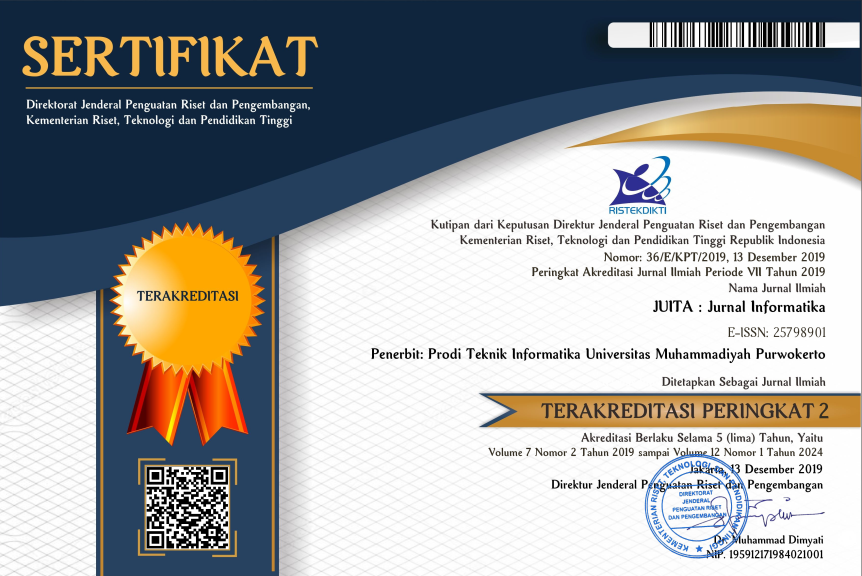Alphabet Recognition with Augmented Reality Technology Based on Android Using Extreme Programming Model
DOI:
https://doi.org/10.30595/juita.v10i1.12125Keywords:
augmented reality, extreme programming, letter recognition, childhood, alphabetAbstract
Lack of literacy or interest in reading is the cause of children having difficulty recognizing the letters of the alphabet and assembling them into words or sentences because the letters are similar. Early childhood students have difficulty learning letters because there are too many letters of the alphabet that must be memorized, the number of letters of the alphabet there are 26 letters that must be memorized. In addition, early childhood students complain that reading is very difficult to pronounce because the way the teacher conveys reading techniques for students is difficult to understand so that it is boring for early childhood students. This makes it difficult for young children to pronounce letters. In software development using Extreme Programming (XP) where writing programs in pairs, two programming people work together to write programs. Currently, computer vision technology has been used in various industries, including trade, medicine, education, and so on. Augmented reality is one of the computer vision technologies. The technology of computer vision is to combine synthetic images into the real world or vice versa. By making an android application with an extreme programming method that utilizes Augmented Reality technology that can display 3D, animation, and sound so that it looks real, it makes early childhood interested and makes it easier for them to learn the letters of the alphabet.References
[1] S. Suyanto, “Dasar-dasar Pendidikan Anak Usia Dini,” Pendidikan, 2005.
[2] A. R. Anisa, D. A. A. Ipungkarti, and K. N. Saffanah., “Pengaruh Kurangnya Literasi Serta Kemampuan Dalam Berpikir Kritis Yang Masih Rendah Dalam Pendidikan Di Indonesia,” 1st Natl. Conf. Educ. Syst. Technol. Inf., vol. 01, no. 01, 2021.
[3] B. Firmansyahputra and A. Cherid, “Aplikasi Multimedia Pengenalan Huruf Alfabet, Buah dan Hewan Menggunakan Teknologi Augmented Reality,” J. Telekomun. dan Komput., vol. 9, no. 3, 2020, doi: 10.22441/incomtech.v9i3.7173.
[4] A. Supriyatna, “METODE EXTREME PROGRAMMING PADA PEMBANGUNAN WEB APLIKASI SELEKSI PESERTA PELATIHAN KERJA,” J. Tek. Inform., vol. 11, no. 1, 2018, doi: 10.15408/jti.v11i1.6628.
[5] Y. Y. Joefrie and Y. Anshori, “TEKNOLOGI AUGMENTED REALITY,” Maj. Ilm. Mektek, vol. 13, no. 3, pp. 194–203, 2011.
[6] O. D. Endah Wulansari, T. Zaini, and B. Bahri, “PENERAPAN TEKNOLOGI AUGMENTED REALITY PADA MEDIA PEMBELAJARAN,” J. Inform. Darmajaya, 2013.
[7] U. M. Arief, H. Wibawanto, and A. L. Nastiti, Membuat Game Augmented Reality (AR) dengan Unity 3D, I., vol. 1. Yogyakarta: Andi, 2019.
[8] N. C. Siregar and M. Marsigit, “PENGARUH PENDEKATAN DISCOVERY YANG MENEKANKAN ASPEK ANALOGI TERHADAP PRESTASI BELAJAR, KEMAMPUAN PENALARAN, KECERDASAN EMOSIONAL SPIRITUAL,” J. Ris. Pendidik. Mat., vol. 2, no. 2, 2015, doi: 10.21831/jrpm.v2i2.7336.
[9] N. D. Retnowati et al., “PERANCANGAN PESAWAT TERBANG DENGAN MENGGUNAKAN 3D BLENDER,” ANGKASA, vol. 5, no. 2, pp. 123–132, 2013.
[10] T. Yuliono, S. Sarwanto, and P. Rintayati, “Keefektifan Media Pemelajaran Augmented Reality terhadap Penguasaan Konsep Sistem Pencernaan Manusia,” J. Pendidik. Dasar, 2018.
[11] N. K. Ilmawan Mustaqim, “Pengembangan Augmented Reality Sebagai Media Pembelajaran Pengenalan Komponen Pneumatik Di Smk,” J. Pendidik. Teknol. dan Kejuru., 2017.
[12] F. Z. Adami and C. Budihartanti, “Penerapan Teknologi Augmented Reality Pada Media Pembelajaran Sistem Pencernaan Berbasis Android,” Tek. Komput. AMIK BSI, 2016.
[13] J. Sutresna, F. Yanti, and A. E. Safitri, “Media Pembelajaran Matematika Pada Usia Dini Menggunakan Augmented Reality,” JUSTIN J. Sist. dan Teknol. Inf., vol. 08, no. 4, pp. 424–429, 2020, doi: 10.26418/justin.v8i4.
[14] A. Nurkholis, E. R. Susanto, and S. Wijaya, “Penerapan Extreme Programming dalam Pengembangan Sistem Informasi Manajemen Pelayanan Publik,” J-SAKTI (Jurnal Sains Komput. dan Inform., vol. 5, no. 1, 2021.
[15] S. A. Prabowo, Sholiq, and F. A. Muqtadiroh, “Rancang Bangun Aplikasi Web Informasi Eksekutif Pada Pemerintah Kabupaten XYZ,” J. Tek. Pomits, vol. 2, no. 3, 2013.
Downloads
Published
How to Cite
Issue
Section
License

JUITA: Jurnal Informatika is licensed under a Creative Commons Attribution 4.0 International License.
















